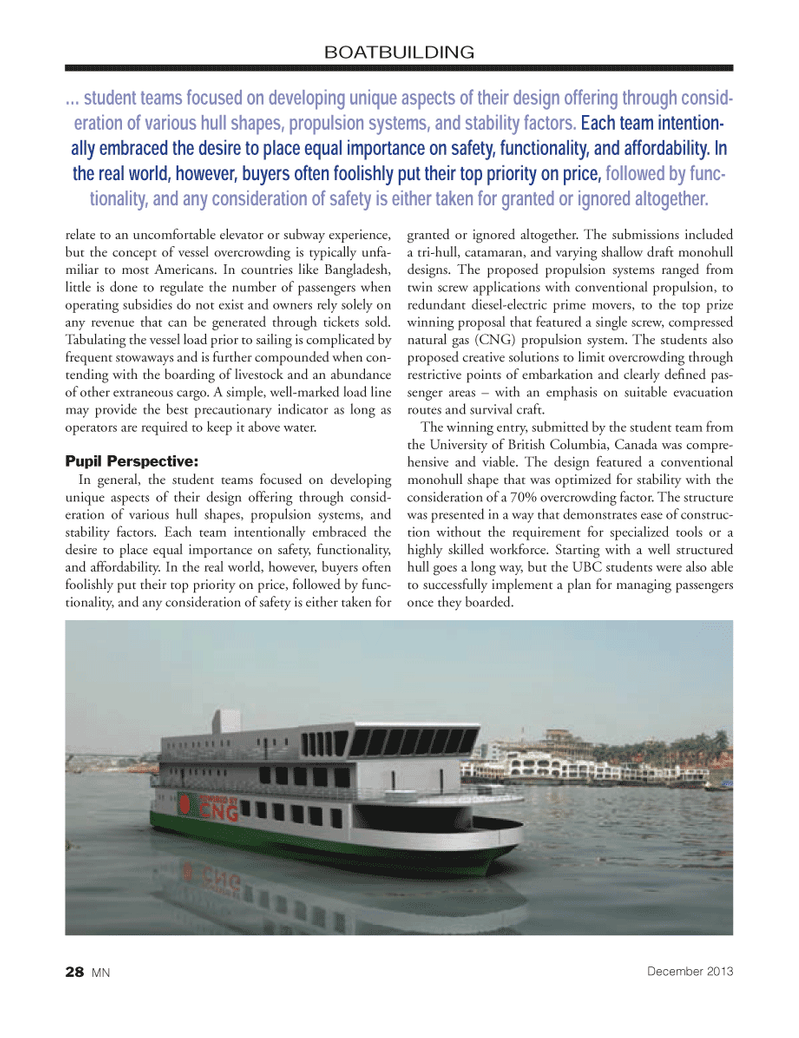
Page 28: of Marine News Magazine (December 2013)
Innovative Products & Boats of 2012
Read this page in Pdf, Flash or Html5 edition of December 2013 Marine News Magazine
relate to an uncomfortable elevator or subway experience, but the concept of vessel overcrowding is typically unfa- miliar to most Americans. In countries like Bangladesh, little is done to regulate the number of passengers when operating subsidies do not exist and owners rely solely on any revenue that can be generated through tickets sold. Tabulating the vessel load prior to sailing is complicated by frequent stowaways and is further compounded when con- tending with the boarding of livestock and an abundance of other extraneous cargo. A simple, well-marked load line may provide the best precautionary indicator as long as operators are required to keep it above water. Pupil Perspective:In general, the student teams focused on developing unique aspects of their design offering through consid- eration of various hull shapes, propulsion systems, and stability factors. Each team intentionally embraced the desire to place equal importance on safety, functionality, and affordability. In the real world, however, buyers often foolishly put their top priority on price, followed by func- tionality, and any consideration of safety is either taken for granted or ignored altogether. The submissions included a tri-hull, catamaran, and varying shallow draft monohull designs. The proposed propulsion systems ranged from twin screw applications with conventional propulsion, to redundant diesel-electric prime movers, to the top prize winning proposal that featured a single screw, compressed natural gas (CNG) propulsion system. The students also proposed creative solutions to limit overcrowding through restrictive points of embarkation and clearly deÞ ned pas- senger areas Ð with an emphasis on suitable evacuation routes and survival craft. The winning entry, submitted by the student team from the University of British Columbia, Canada was compre- hensive and viable. The design featured a conventional monohull shape that was optimized for stability with the consideration of a 70% overcrowding factor. The structure was presented in a way that demonstrates ease of construc- tion without the requirement for specialized tools or a highly skilled workforce. Starting with a well structured hull goes a long way, but the UBC students were also able to successfully implement a plan for managing passengers once they boarded. BOATBUILDING ? student teams focused on developing unique aspects of their design offering through consid-eration of various hull shapes, propulsion systems, and stability factors. Each team intention-ally embraced the desire to place equal importance on safety, functionality, and affordability. In the real world, however, buyers often foolishly put their top priority on price, followed by func-tionality, and any consideration of safety is either taken for granted or ignored altogether. December 201328 MNMN Dec2013 Layout 18-31.indd 28MN Dec2013 Layout 18-31.indd 2811/25/2013 12:46:37 PM11/25/2013 12:46:37 PM

 27
27

 29
29
